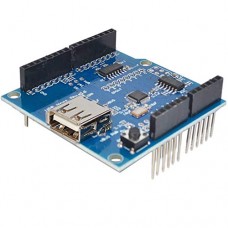Shopping Cart
0 item(s) - USD 0.00- 5W Resistor (6)
- Arduino Development (64)
- Audio (8)
- Batteries (17)
- Cable & Wire (36)
- Capacitors (41)
- Charger (7)
- CNC Machine (4)
- Connector (26)
- Connector (3)
- Connector & Sockets (3)
- Crystals / Oscillators (9)
- DCA Professional Power Tools (0)
- Development Tools/ Programmers (10)
- Digital Oscilloscope (0)
- Display (65)
- Domino (5)
- Driller (16)
- ECOSPARKS PRODUCTS (0)
- Electrical Products (1)
- Ferrit (1)
- GPS Module (5)
- GSM Module (8)
- Headers (15)
- Heat shrinkable tubing (7)
- IC-Driver (17)
- IC-Microcontroller (31)
- IC-OpAm (13)
- IC-Timer (5)
- Inductors SMD (0)
- Inductors/Coils/Chokes (16)
- Integrated Circuits ( ICs ) (1)
- Max Family (7)
- Micro SD (7)
- Module Bluetooth/ Bluetooth (5)
- Module Relays (6)
- MosFet & Fet (15)
- Motor Pump (4)
- Optical Sensor (11)
- Optocouplers (3)
- Other Products (1)
- Over Voltage / Current (11)
- PCB (16)
- Potentiometers / Variable Resist (16)
- Power Supply (16)
- Projects Box (1)
- Raspberry Pi (31)
- Regulators (20)
- Relays (11)
- RePair Battery LapTop (2)
- Resistor-Network (3)
- Resistors (52)
- RF IC, Module (13)
- ROBOTIC (55)
- Semiconductors (0)
- Sensors / Transducer (82)
- Service and Repare (0)
- Smart Home (2)
- Socket-IC (10)
- Solar Panel (4)
- Solder (8)
- Soldering Tool (28)
- Specialized Function IC (10)
- surface mount (SMD) (35)
- Switches, Key Pad (25)
- Terminal block (11)
- Test & Measurement (21)
- Testboard (6)
- Tools & Supplies (57)
- Transistor (32)
- Triac (3)
- USB Connector (10)
- USB to Serial (13)
- WiFi Module (13)
- Wire Termial (15)
- Diodes (20)
- IC-Logic Family (29)
USB Host Shield for Arduino UNO MEGA 2560 Support Google Android ADK USB HUB
Availability: In Stock
Add to Compare
Description
- USB Host Shield for Arduino UNO MEGA 2560.
- Support the Google Android ADK.
- Compatible with Arduino Uno 328.
- Compatible with Arduino Diecimila / Duemilanove 328.
- Compatible with Arduino Mega 1280.
- ›See more product details.
USB Host Shield Support Google Android ADK & UNO MEGA Duemilanove
2560 Arduino
Description:
1.Support the Google Android ADK, supporting Android phone: G1,
Nexus One, Nexus S, Motorola Droid X.
(Mobile systems need to upgrade to Android 2.3.4, tablet PCs
need to upgrade to Android 3.1).
2.Provides APK package, and compiled source files ADK Compatible
with Arduino.
3.Compatible with following hardware.
Arduino Uno 328.
Arduino Diecimila / Duemilanove 328.
Arduino Mega 2560 (recommended).
Arduino Mega 1280.
4.After achieving the Arduino USB HOST function, can communicate
with other USB devices, and support USB HUB function.
Reference webpage:
http://www.circuitsathome.com/category/mcu/arduino
Libary: https://github.com/felis/USB_Host_Shield_2.0
How to estabish ADK hardware
Platform:http://www.circuitsathome.com/mcu/building-google-adk-hardware-from-standard-components
Package Includes:
1 * USB Host Shield Support Google Android ADK & UNO MEGA
Duemilanove 2560 Arduino
Getting Started
First, make sure you have setup the development environments for Arduino and Android:
Hardware
Parts needed:
- Android Device (1.6+)
- 3x LED Lights
- 3x 330 ohms resistors
- Breadboard
- Power supply
- Hook-up wire
- Android ADK Board*
- – OR –
- Arduino compatible and USB Host shield
*Supported boards include:
Google ADK board, Freeduino ADK board , Seeed Studio ADK board, and DIY Drones ADK board
Assembly
Connect the 330 ohm resistors in series with the anodes of the LEDs to the desired digital output pins, and the cathodes of the LEDs to ground. The example uses digital pins 2, 3, and 4, but can be used with any IO pin that doesn’t interfere with the SPI communication with the USB Host Board. For most boards, these are pins 10 – 14. The resistors, in this case, are being used to prevent current overdraw to the LEDs. Here is a diagram of the completed circuit (created with Fritzing):
Software
Arduino Firmware
Next, upload the Arduino sketch to the microcontroller. The sketch uses the Microbridgeimplementation by Niels Brouwers. Microbridge uses Android Debug Bridge (ABD) forwarding over TCP, rather than the official Google Android ADK. You can checkout the source for the Arduino sketch from Github, or just copy and paste the following into the Arduino IDE.
Write a review
Your Name:Your Review: Note: HTML is not translated!
Rating: Bad Good
Enter the code in the box below:
Cambodia Electronic Source © 2024








